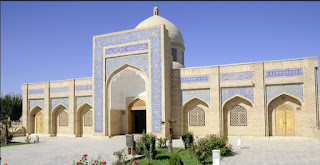Khwaja Bahauddin Naqshband
Khwaja Bahauddin Naqshband
The complex begins with a small domed gatehouse. After passing through the gate, it is known that there was a small mosque on the right and various buildings for pilgrims on the left. Along the way, on the left is the tomb of the Khans - Dakhmai Shahon. Dakhmai Shahon is rectangular in shape, bal. 2.5 m, covered with gray marble. There are excellent examples of marble carving and calligraphy. Shelves, columns, honors, cypress images, etc. are placed on the marbles. ornaments carved; patterns are sometimes mixed with inscriptions.
The passage through the Dakhmai Shahan leads to an elegantly decorated peshtoq (the double-layered door of the peshtoq is carved with "baghdodi" and "guli nav" patterns). After passing through the door of Peshtoq, there is a domed mausoleum on the right (it is not known who was buried in it). On the left, at the entrance, there is a 6-pillared (simple) Mu-zaffarkhan mosque with a front porch. Next to the mosque is the 2-pillared Hakim Qushbegi mosque (there is a wonderful sculpture on the mosque's mihrab).
Sufism, the Khojagon-Naqshbandiya order drew on ancient ties in the formation of its ideas, procedures, manners and determination.
The complex begins with a small domed gatehouse. After passing through the gate, it is known that there was a small mosque on the right and various buildings for pilgrims on the left. Along the way, on the left is the tomb of the Khans - Dakhmai Shahon. Dakhmai Shahon is rectangular in shape, bal. 2.5 m, covered with gray marble. There are excellent examples of marble carving and calligraphy. Shelves, columns, honors, cypress images, etc. are placed on the marbles. ornaments carved; patterns are sometimes mixed with inscriptions.
The passage through the Dakhmai Shahan leads to an elegantly decorated peshtoq (the double-layered door of the peshtoq is carved with "baghdodi" and "guli nav" patterns). After passing through the door of Peshtoq, there is a domed mausoleum on the right (it is not known who was buried in it). On the left, at the entrance, there is a 6-pillared (simple) Mu-zaffarkhan mosque with a front porch. Next to the mosque is the 2-pillared Hakim Qushbegi mosque (there is a wonderful sculpture on the mosque's mihrab).
It has patterned porches on the south and plain porches on the west. Bahouddin Dakhmasi is a large murabba-shaped supa covered with marble, surrounded by a beautiful marble fence. A little further, in the north, there is a circular marble pool with a length of 9.5 m. on the side, there is a smaller, beautiful hall. Between Bahauddin's shack and the pond is a well, and from a beautiful shed next to it, pilgrims were given "holy" water in various shaped containers.A room (37 m wide, 40 m tall) was built on a rectangular platform outside the courtyard (north-west). In the center, there is a mosque surrounded by porches, with a mihrab made in the style of Chorzamin. On both sides of the building there were symmetrically built two-story large and small rooms. "Qasri Orifon" mosque, located 0.5 km northeast of it, is included in B. m.; next to it is a small tower. The mosque is surrounded by ivy on 3 sides; a pool with a ceiling pattern. B. m. 16-a. It is an example of achievements in building a new ensemble of architecture, which differs from symmetrical ensembles with double buildings.
On the initiative of the President of the Republic of Uzbekistan Islam Karimov, the 675th anniversary of the birth of Bahauddin Naqshband was held (1993), the complex was renovated, additional buildings were built















Comments
Post a Comment